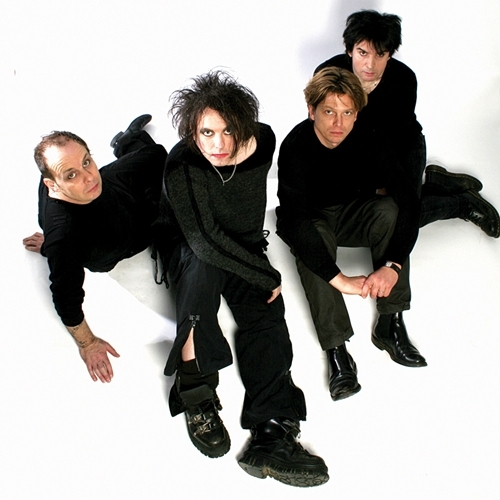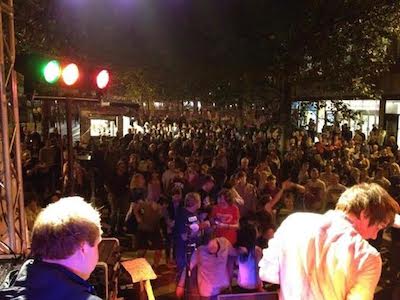For over thirty years The Cure has successfully held a place in the alternative scene both in the UK and abroad. Formed in 1976 in Crawley, the band has seen many changes in both line-up and stylistic direction whilst still maintaining a core sound that is undeniably their own. With fifteen studio albums spanning from their debut in 1979 to 2008’s ‘4:13 Dream’ it is easy to recognise the influence of the group on popular culture and their ability to stand the test of time and remain relevant without compromising artistic expression or integrity.

The Cure’s debut album ‘Three Imaginary Boys’ released on Fiction Records in 1979, just three years after the group’s formation may not give a good indication of the future direction of the band, but it is not devoid of subtle hints at what they were later to become. While this album is rife with heavy, punk influenced tracks ranging from ‘Grinding Halt’ to ‘So What’ along with their very odd cover of Hendrix’s ‘Foxy Lady’, there are some stellar tracks which begin to point towards the dark, pensive music that would later become a signature sound for the band. Tracks like ‘10:15 Saturday Night’, and ‘Another Day’ are not completely divorced from the punk sound the band emerged from, but begin to expand beyond it both musically and thematically into something darker and more multi-dimensional.
‘Boys Don’t Cry’ was released a year later in 1980 on Elektra. The sophomore release shares many of the same tracks as its predecessor, simply replacing some of the weaker tracks in favour of newer more solid material. This album was released with the intent of garnering a following outside of the UK, and it received a fair amount of success with tracks including the defining title song along with ‘Jumping Someone Else’s Train’, and ‘Killing An Arab’ (a track which received some controversy for its seemingly racist theme and as a result, was later removed from radio play at the group’s request). Undeniably there was still a punkish flavour to the new tracks, but the sound of the band was developing into something much less raw.
The follow-up album ‘Seventeen Seconds’ explored further changes, including the replacement of original bassist Simon Gallup with Michael Dempsey and the addition of Mathieu Hartley on keyboard. This record possesses a very sparse sound representing the group’s journey into more serious territory, divorced almost completely from its distortion led-punk beginnings. While there are certainly some very worthwhile tracks on this album, it is forgotten to all but the most avid fans with the exception of its major single, ‘A Forest’.
1981’s ‘Faith’ saw the departure of Mathieu Hartley and it marked The Cure’s first truly solid album. As an exploration of sadness and spirituality ‘Faith’ was a giant leap forward musically and lyrically for the group. Frontman Robert Smith’s vocalisations also began to develop during this period into the dark crooning that has become his signature style. With its funereal sound ‘Faith’ remains one of the most beautiful, solid, and wholly underrated albums in The Cure‘s discography.
These desolate soundscapes laid the foundation for 1982’s ‘Pornography’. While this record was not regarded well by critics upon its release, the album has become one of the most highly regarded whole albums released by the band. This is arguably the darkest they’ve ever produced. ‘100 Years’ and the single ‘The Hanging Garden’ are both the heavily atmospheric, depressive and emotionally turbulent tracks that have come to be expected from The Cure, while the title track lends to a fractured and angry ending to the album. Many of the tracks between, while still enjoyable and interesting to listen to, do not contain the same emotional power as substance was seemingly sacrificed for the sake of sound.
After a particularly volatile tour the group was reduced to frontman Robert Smith and drummer Lol Tolhurst. With the assistance of studio musicians the pair recorded ‘The Top‘, a short album released on Sire Records that signifies the group’s move toward a more pop-focussed sound. The recording of ‘The Top‘ coincides with Robert Smith’s brief tenure as a member of Siouxsie And The Banshees, which may have been a contributing factor to the shortness of the album. While tracks like ‘The Caterpillar’, ‘Bird Mad Girl’ and ‘Piggy In The Mirror’ are well worth a listen, overall the album falls short and doesn’t feel finished.
By 1985 Porl Thompson and Simon Gallup had rejoined the group in addition to Boris Williams joining on drums. The Cure released ‘The Head on the Door‘ (Elektra), one of their finest albums to date, and the recording which most successfully combined both the dark elements of the group’s work and more poppy danceable trends in music as can be seen in the widely successful singles ‘Inbetween Days’ and ‘Close To Me’. Tracks such as ‘A Night Like This’ and ‘Sinking’ still maintain the darkness of previous albums, but manage to co-exist harmoniously with the poppier tracks on the album. It was the hit-making power of this album that paved the way for ‘Staring at the Sea’, the singles collection released in 1986.
The next year brought the arrival of yet another band member, keyboardist Roger O’Donnell and also saw the release of The Cure’s eighth album Kiss Me, Kiss Me, Kiss Me’ on Fiction Records. As the group’s most ambitious project, ‘Kiss Me…’ is an eclectic double album featuring funk-influenced rhythms, a string section, and horns. It’s a record that truly has something for everyone from the angry guitar shredding and howling of Smith on ‘The Kiss’ to the beautiful love song ‘Just Like Heaven’ and the danceable, upbeat tune ‘Hot, Hot, Hot’. While the ideas and themes of this album never completely gel, the recording overall is one of the finer examples of the group’s range and song writing ability and it’s well worth owning whether you are the avid collector or simply a casual fan.
After a highly successful world tour promoting the last album the group began work on ‘Disintegration’ which was released in May of 1989. This record is often regarded as the peak of The Cure’s discography, and not without good reason. The album releases the atmospheric potentials of the group’s music which had been building from the very beginning. From the expansive and alluring ‘Pictures Of You’ to the pulsing ‘Fascination Street’ and the heart-wrenching, honesty of ‘Lovesong’ the record moves forward, never missing a beat.
By 1990 both Lol Tolhurst and Roger O’Donnell had left and Perry Bamonte joined on keyboards and ‘Mixed Up’, a collection of remixes featuring new recordings of ‘A Forest’ and ‘Close To Me’ was released. Two years on saw the release of ‘Wish’, The Cure’s eleventh studio album. After the incredible success of ‘Disintegration’, ‘Wish’ comes off feeling a little bit soulless and even-handed. Despite the less compelling nature of the album, it presents some worthwhile tracks including ‘Friday I’m In Love’ and ‘A Letter To Elise’. Taken upon its own merit, ‘Wish’ remains a very competently executed album with a good flow.
The year 1995 found further changes in The Cure’s lineup with the departure of Boris Williams, who was replaced by Jason Cooper and the rejoining of Roger O’Donnell. In 1996 ‘Wild Mood Swings’ was released. This is another eclectic album exploring many different styles and influences. ‘This Is A Lie’ and ‘Jupiter Crash’ are positive examples of Smith’s emotive vocal style while ‘Mint Car’ displays a more pop-centric direction and ‘The Thirteenth’ showcases a mariachi style rarely found in popular music. The Cure were in rare form on this album, pulling out the stops and showing off a range of influences.
‘Wild Mood Swings’ came under fire from many fans who believed that the group had completely shed their goth-rock sensibilities for a more pop-orientated sound. 2000’s ‘Bloodflowers’ was Smith’s best effort to give the people what they wanted. The album returns to the more languid, ambient music the group has always been known for. While the album is enjoyable, the songs feel in many ways less powerful than previous albums. One gets the sense that Smith is neither pushing himself nor the rest of the band to higher heights, rather he is settling for what he believed the fan base was looking for. ‘Maybe Someday’, ‘The Last Day Of Summer’ and ‘Watching Me Fall’ stand out as the most genuine tracks on this album.
After years of Smith indicating that he intended to disband The Cure and move on to possibly a solo career or another group, 2004 marked the release of a self-titled album produced by Ross Robinson who is known for his work producing metal groups such as Limp Bizkit and Korn. However, this release is very relaxed, and it doesn’t try to recapture the past. While it is far from positive, the album seems to show a much more contented, resigned side of the group. ‘The End Of The World’ and ‘I Don’t Know What’s Going On’ show a lighter side while tracks like ‘Anniversary’ and ‘Labyrinth’ display a quiet, lamenting sentiment. While this album is not as dark or intense as earlier works, it has some worthwhile tracks.
In late October, 2008 The Cure released their fifteenth album ‘4:13 Dream’ (Geffen). This starts off strong with ‘Underneath The Stars’ an expansive, ambient song in the vein of older recordings. Sadly the momentum of the opening track begins to give way quickly into poppier sounds that lack the tightness or genuine feeling that songs like ‘Friday I’m In Love’ or ‘Let’s Go To Bed’ gave in abundance. This is not to say ‘4:13 Dream’ is a terrible record or devoid of any value, but it pales in comparison to the rest of the discography.
Do you agree or disagree with my look back at The Cure’s albums? Let me know below.
For more information visit the band’s Myspace and website.



